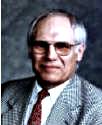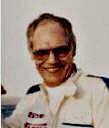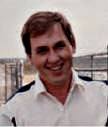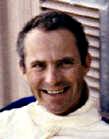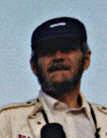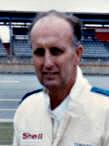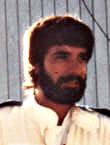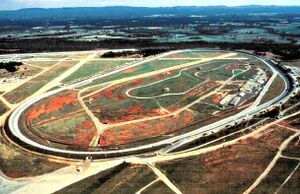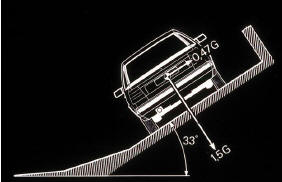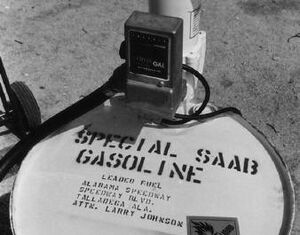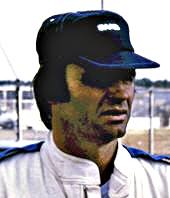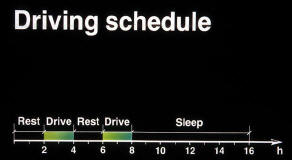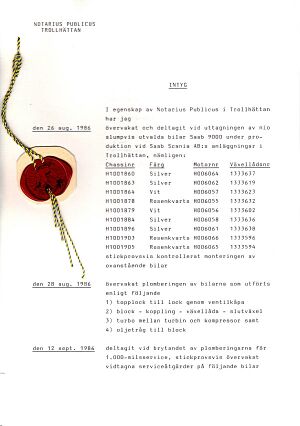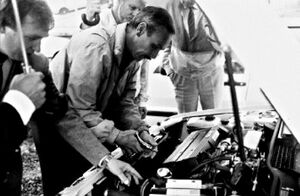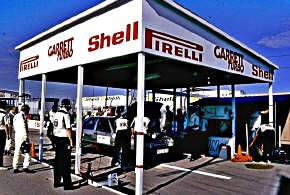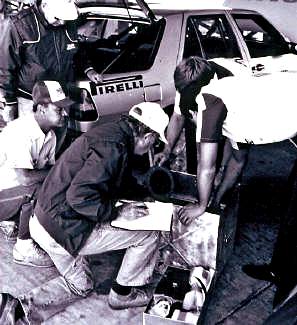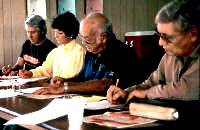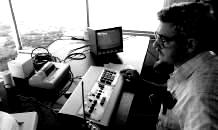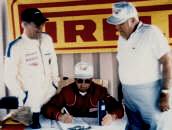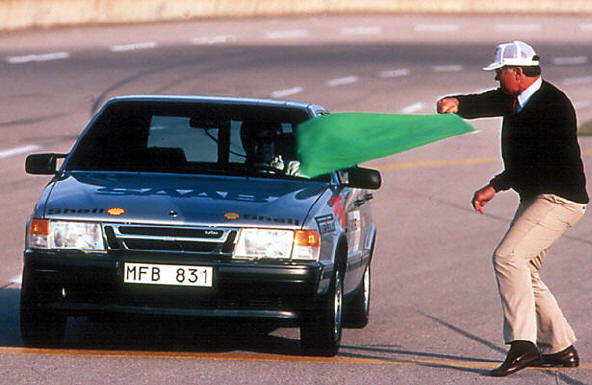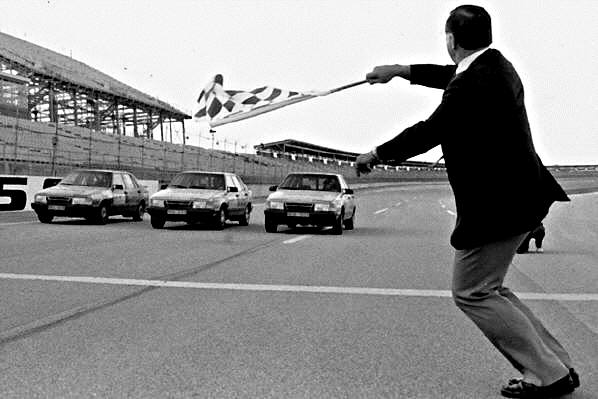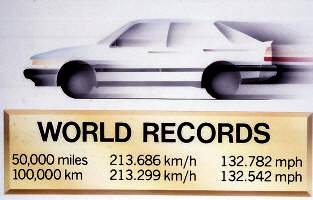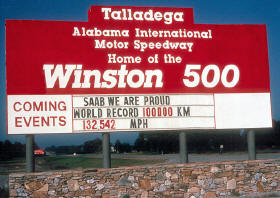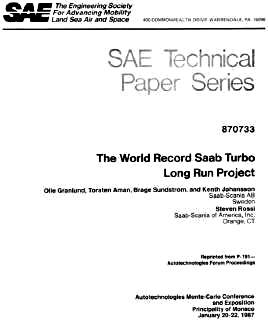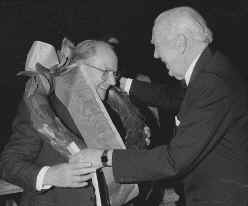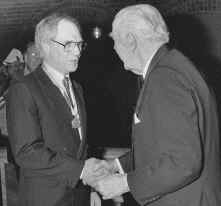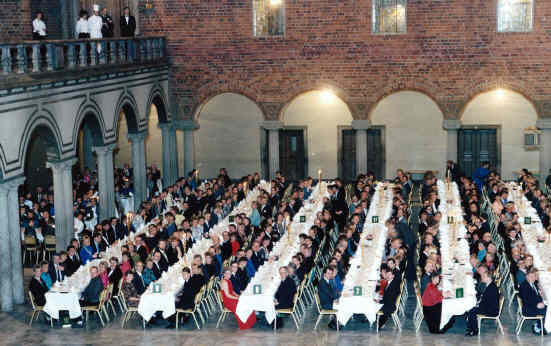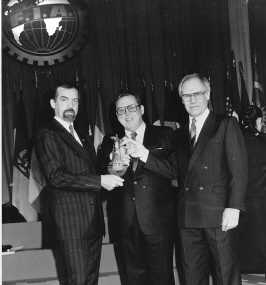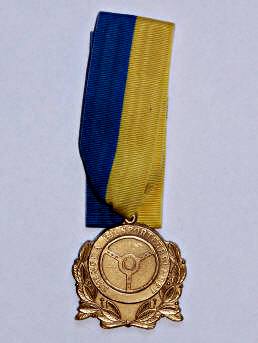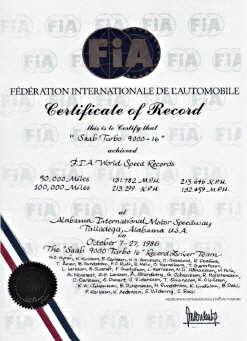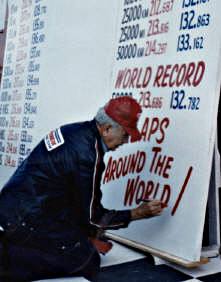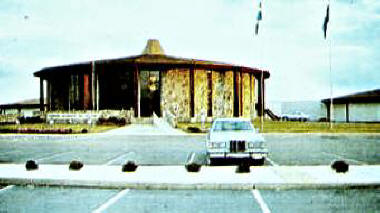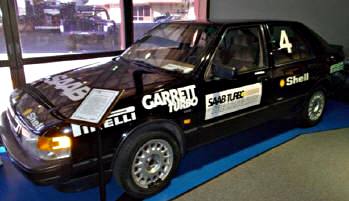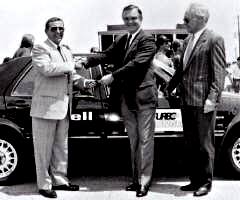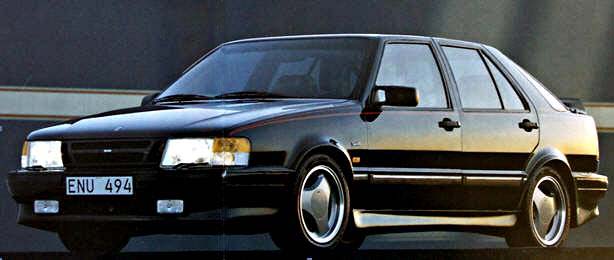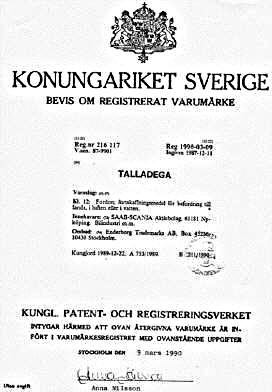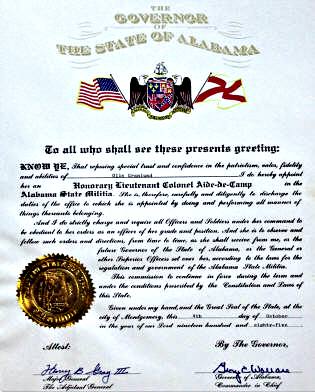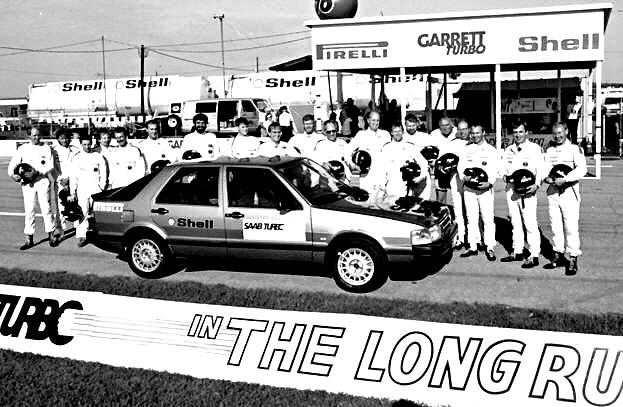Talladega 1986 Saab Turbo "The Long Run"
Written by Olle Granlund, the initiator and project leader for The Long Run
Innehåll
- 1 Purpose
- 2 Background
- 3 Initial idea
- 4 Proposal to attempt a world record
- 5 Pre test initiation
- 6 Regulations
- 7 Homologation / Classification
- 8 The Project organization
- 9 Time-schedule
- 10 The financial Budget
- 11 Sponsor contracts
- 12 Choice of race track
- 13 Pre test
- 14 Pre test personel
- 15 Hotel Accommodation
- 16 Observations
- 17 Drivers
- 18 The Driving Schedule
- 19 Selection of Vehicles/Transport
- 20 The "Pit"
- 21 Spare Parts
- 22 Timekeeping, pit control
- 23 The start of The Long Run
- 24 Diary
- 25 Barbecue celebration party
- 26 SAE paper
- 27 Honoring our achievements
- 28 Record Table
- 29 The Talladega version of the Saab 9000
- 30 Talladega diploma
- 31 Some interesting data
- 32 Press and Information
- 33 Jubilee
- 34 Resume
Purpose
This report outlines the events surrounding the completion of "The Long Run" and also includes relevant facts and figures that can be used as a reference for future use.
Background
Upon the introduction of the turbo-charged engine in the Saab 99 with its increase in power it became quickly apparent that the car was ideally suited for high speed highway driving.
During this particular time Saab did not have close access to its own test track so the German Autobahn was used to perform high speed test schedules.
Valuable test data was attained from the Autobahn tests, often resulting in engine design changes being made to improve reliability. It didn’t take too long before a 60000 km high speed endurance test was performed without any major problems being noted.
Driving on the Autobahn had its restrictions which prompted a decision being taken at Saab to perform all high speed driving tests at the Nardo test facility in southern Italy.
The Nardo test track was built and owned initially by Fiat, however, after a period of time, the test track was sold and operated privately.This gave European car manufacturers the opportunity to use the test facility and perform for themselves high speed test schedules in safer and more favorable test conditions.
The Saab 9000 was tested at Nardo throughout the whole of its development process.
Initial idea
At the Frankfurt Auto-Show in the Autumn of 1983 Mercedes Benz presented a 190 Model E , 2,3liter, 16 valve engine which had been used to beat world speed records over distances of 25000 km ,2500 miles and 50,000 km at the Nardo test facility.
The English engine tuning company Cosworth had been assigned to develop the cylinder head so that a maximum engine power rating of 185hk was attained. The 4-cylinder in-line engine was equipped with two overhead camshafts,16 valves and fuel-injection.The car was said to achieve a maximum speed of ca.250 km/h.
This record breaking vehicle had been extensively modified i.e.the chassis was lowered 45 mm to account for a lower front spoiler and the the rear axle had undergone ratio changes.
Low rolling resistance Pirelli tires were also used having a rolling resistance of 13hp at 250 kmh –the rolling resistance of standard Pirelli tyres was noted as being 27hp at 250 km/h.
The vehicles drag coefficient (Cw) had also been measured at an impressively low 0,285.
I personally visited the car show in Frankfurt myself attending the launch of Saabs 16 valve Turbo engine. It was here that I first saw Mercedes record breaking vehicle.The vehicle had been taken directly from the test track facility at Nardo, unwashed and with the front of the car and winscreen areas covered with flies and insects.
I was most impressed by the achievements of Mercedes and it is here where I began to initially start thinking of how a turbo-charged Saab 9000 would perform in such a test?
Saabs most recent high mileage endurance tests at Nardo in Italy with the Saab 9000 had been completed without any major problems being noted.
Upon my return to Saab I could not stop thinking about performing such a test. I initially contacted Bo Hellberg at Saabs competition department who had many contacts in the Swedish car sport Association and the FIA (the international car sport organization based in Paris) and explained for him my thoughts and ideas.
I considered it important that the whole idea of performing the tests remained a strict secret,at least until I had gathered more information of just what was required. I needed more details of what was involved before I could make a proposal to Saab´s management.
I didn’t want them to consider me as one for taking far too many risks!
Bo Hellberg found out that passenger cars were classified in four groups:- A. Special Automobiles. B. Series produced Touring cars (5000 units). C. Special vehicles (jet, rocket, etc). D. Ground effect Vehicles.
Mercedes broke their record in group A. for Special Automobiles ,their record breaking vehicle had been lowered and extensively modified.
In Class A.several records had been broken at considerably short distances,e.g.Audi had broken the world record at Nardo at a distance of 1000 km at a speed of 326 km/h.
The car in question was a heavily modified Audi 200 Turbo Quattro, with a turbo charged, 5 cylinder engine developing 650 hp.
At this point it was obvious that for Saab to perform a similar test in Class A would require enormous resources and would be very expensive.
On the other hand,a world record attempt with a car in Class B. could be a lot easier to achieve and at a lower cost?
In Class B. there was already an existing world record at 50,000 miles achieved in September 1983 with a Ford Comet.The car registered a world record at an average speed of 175 kmh at Daytona.
It was this record we were sure we could beat.Here then was the opening we were looking for and where probably our best chance of success would be.
Upon a world record attempt being made the regulations state that Groups A and B shall be combined.
Considering this it would be easier (and with a better chance of success) to have a vehicle in Class A. which could be extensively tuned and modified. On the other hand,such vehicles are more prone to problems affecting reliability. This can clearly be seen by the lack of records performed at longer distances.
Our conclusion then was that a totally standard vehicle taken direct from production would be far more advantageous both in a marketing perspective and good for the company´s reputation for quality and reliability.
Proposal to attempt a world record
With all the knowledge I had acquired I became more and more convinced that we had a good chance of breaking a world record.Indeed it would be very nice proving to the world what a good product SAAB was!
On the other hand should we fail it could be very embarassing for us all!
On the 1st of November 1984 I wrote a Saab internal pm outlining my proposal to perform the test. The pm was sent to SAAB´s chief of engineering Stig Göran Larsson ,technical director Henrik Gustafsson,director of sales Bengt Ödman and PR director Hans Thörnqvist.
Stig-Göran reacted quickly and indicated that he thought my proposal was very interesting but he felt we should wait until 5000 Saab 9000´s with the new 16 valve engine had been built.This was also the volume required for the vehicle to be classified as being series produced.
Time passed by without any direct response from upper management to my PM until one particular day in February 1985 when I was called up on the phone by Saabs managing director Sten Wennlo.
Sten informed me that he had read the pm that I had written.His immediate reaction to it was short and concise saying it was a good suggestion and that we should start work on it immediately.
At first I was not sure if I was hearing correctly which made me a little hesitant in replying …..
Then Sten started to get a little irritated saying sharply, "don’t you believe in what you have written?"
I was forced to quickly change my tone somewhat and stated that the suggestion was indeed well founded and completely thought through.
His final words were then "OK lets go for it".
Pre test initiation
Following the telephone call with Sten Wennlo,which basically gave us the green light to go ahead and make the test ,it didn’t take too long for Saabs special project team to evaluate the implications of performing such a test. Below are some of the general concerns,questions and areas which needed immediate attention :
-Clarification of the legal regulations.
-Creation of a Project team and organization.
-Choice of test track.
-Homologation of the Saab 9000.
-Generate a detailed time plan.
-Generate a preliminary budget.
-Establish contact with possible sponsors.
Regulations
Bo Hellberg spoke with his contacts at FIA and had received clarification in certain areas. One of them being the reasons why there had not been a high speed record broken with cars in category B.
On the 2 May 1986 a meeting was held together with a SAE conference in Chicago with Burdette Martin who was the chief at ACCUS (Automobile Competition Committee for the US).
The following staff from Saab were at the meeting: Bo Hellberg ,Steven Rossi, Per Gillbrandt and myself Olle Granlund.
The main topic of the meeting was to discuss the organization and planning of the test.
One of the most important decisions taken was that NASCAR ( National Association for Stock Car Auto Racing )would be responsible for controlling the test and would have their own time keepers and controllers following up activities in the pit area. Les Richter was given total responsibility at NASCAR along with Joe Elton the chief steward.
From Saab, Brage Sundström was responsible for contact with NASCAR.
Looking back I can safely say that we established a very good working relationship with the staff at ACCUS and NASCAR.
Homologation / Classification
The FIA is the organizations that approves all speed records and require that vehicles used for the tests have been homologated in a similar manner as for all other competition vehicles.
The Saab 9000 with the new 16 valve engine was not initially homologated. Brage Sundström started work immediately on getting the vehicles certified.
On the 1st of July a certificate of compliance was received.
The Project organization
Once all initial concerns surrounding the tests were discussed and accounted for, it was time to appoint the Project Team. It was felt most important that the organization consisted of staff that were experienced in specific areas.
The project team was formed including the following members of staff
Time-schedule
A well formulated time schedule was also necessary in order to keep track of the projects activities, many of which were needed to be performed simultaneously.Several sub-project leaders were also appointed having clearly defined roles of responsibility within the project.Regular meetings were held discussing the time schedule. In general everything flowed without problem and set milestones were reached on time.
The financial Budget
A preliminary cost analysis was made in order to gain a reasonable idea of the money needed to be budgeted for in completing such a test. Initially a figure of 6,5 msek, was calculated as being needed. This excluded sponsorship costs for fuels, oils and tires etc.
Sponsor contracts
In depth discussions took place regarding sponsorship with many companies but we decided that it would be best for Saab to work together with 3 main sponsers.
Shell
Shell was responsible for the delivery of fuels and oil in accordance with the test regulatations and the requirements of SAAB. The regulations stipulated that fuel in accordance with national specifications of the land where the vehicle is manufactured shall be used. Shell in the US later refined a 98 octane fuel according to Swedish specifications at its refinery in Houston ,Texas. The fuel was later transported to Talladega in large fuel delivery trucks along with equipment for filling the test cars.Approximately 75 000 liters of fuel per car was calculated as being required.
Pirelli
The choice of tires used for testing the vehicles would play a vital role in the completion of the test.
A recommendation from Pirelli staff working at Talladega was that normal standard tires would offer the best performance and durability.
Pirelli's staff were very familiar with tire wear and separation that had caused problems for many manufacturers performing high speed tests on race tracks.
A pre-test was performed in September 1985 at Talladega allowing Pirelli´s engineers to determine if tire temperatures and wear patterns were at an acceptable level.Their final recommendation was that the ideal tire for completing the test would be a Pirelli P600,225/55/VR15.
An additional advantage for this particular tire, was it also performed well in wet weather driving conditions.This proved also to be
true during a heavy rain storm that occurred during the test.
Garrett
The Turbo manufacturers Garrett were eager to be a sponsor and in return for this they required continual technical data feed back of the Turbo chargers performance throughout the pre test.
At that time there was a great deal of doubtfulness surrounding the use of turbo chargers within the motor industry. This maybe was an ideal chance for Garrett to prove once and for all that their modern water cooled turbo charger was capable of enduring extreme driving conditions?
Choice of race track
The regulations stipulated that the race track should be either oval or completely circular with curves running in the same direction.
The number of European tracks fulfilling these regulations was very limited. One alternative high on Saabs list of preferences was the high speed test facility at Nardo in Southern Italy.
Saab had been using this particular track for development work for some considerable time. The track was identical to the regulations in such that it was completely round covering a distance of 12,8 km. The climatic conditions in the area were also very favourable.
A special characteristic of a large diametercircular track is that drivers hardly notice that they are actually driving on a circular track –drivers tend to get the feeling as if the vehicle is being driven in a straight line!
This is particularly advantageous for keeping tire wear down to a minimum. Initially it was Saabs desire to hire for themselves the Nardo test facility for a period of 3 weeks. This was however rejected by the track owners due to contracted commitments with other manufactures that needed to use the track.
Another race track in Italy was Monza. The oval track here unfortunately had not been used for a considerable amount of time and was in such poor condition that testing there was quickly rejected.
The third and final track in Europe to be considered was Montlhéry in France which was completely round with steep banking. Driving on such a track would however cause the chassis to bottom out on one side causing high loading on the chassis components and excessive wear on the tires.
This track was by no means suitable for performing such a test.
The search for a track to perform the test on in Europe was interrupted and the race tracks in the USA i.e. Bonneville, Indianapolis, Daytona and Talladega were considered as being suitable alternatives.
Saabs contact person in the US Steven Rossi was contacted, who later made a full examination of interesting race tracks.
Talladega was judged to be the best option and would be ideal for performing our attempt on a world record.
On the 12 august 1985, Steven and I visited Talladega primarily to gain a general impression of the race track and also to discuss with staff at Talladega just what arrangements were needed, should we decide to test there.
We managed to get a good working relationship with the chief of Talladega speedway ,Don Namen and cooperation was further strengthened as the test progressed. I felt that the staff at the racetrack had a high respect for Saab and we learnt that they felt that we were one of the best teams that had used the Talladega race track.Indeed a nice recognition!
Talladega Race Track
The Talladega race track is officially named the Alabama International Motor Speedway and was built in 1968 on an old military airfield. The race track is used for stock car racing i.e. The Winston 500 is twice a year driven there and is considered to be the fastest track in the USA. A world speed record was made on this track by Mark Donahue in a Porsche 917 achieving a speed of 355 kmh.
The highest speed for stock cars was set by Cale Yarborough in a Chevrolet Monte-Carlo SS at a speed of 325 kmh.Indeed very impressive results.
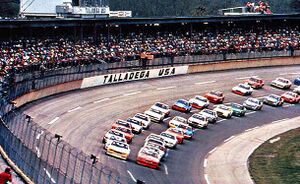 Winston 500 race, 150 000 spectators
Winston 500 race, 150 000 spectators
The Talladega speedway was designed by Bill France and is known as being "tri-oval" i.e. having two curves with 33° banking angles and one further curve with a banking angle of 18°.
To be able to use the Talladega race track for setting a world record the FIA required that the racing track was fully certified and precisely measured. This had earlier been done upon a record attempt undertaken by Audi ,so for us at Saab it was just a matter of starting our test.
The race track's length is 4,28 km measured 36 inches from the tracks inner diameter and has seating accommodation for 75 000 stock car spectators and room for a further 70 000 spectators on the inside track areas.
Upon a manufacturer using the race track all safety arrangements have to be in operation. During the time Saab was using the race track the following was included in the cost of hiring the track:
- A medical room and ambulance staff on 24 hour duty.
- 3-4 fire tenders with fire fighting teams strategically placed around the track.
On the first evening of driving the lack of lighting around the track made driving difficult especially in the banked curves.Extra spotlights fitted to the vehicle didn’t improve matters either.
A reflective line painted on the tracks inner radius could have improved the situation however NASCAR rejected this due to the claimed small glass particles in the reflecting paint would cause damage to the tires of vehicles competing in the Winston 500 race.
The final solution was to have the race track´s yellow warning lights activated close to the approaches into the banked curves.
Also assisting drivers was a continual white line painted on the inner radius of the track.
Driving on the Talladega race track
Driving at 175 km/h vehicles remain in a state of balance (equilibrium) when driving on the banked curves of the track (ref. diagram), however, the Saab test car was going to be travelling at considerably higher speeds, i.e. at speeds between 225-230 km/h which affected the vehicles aerodynamic stability. Side acceleration increased to 0,47 g with a corresponding vertical acceleration of 1,5 g (ref. diagram).
Vehicle in state of balance (equilibrium) on the banked curves. Side and vertical forces.
These adverse conditions caused the vehicle to have a tendency to slide somewhat. A slipangle 1,5° was measured (certain video clips from the tests can be seen confirming this).
A check of the chassis settings during driving revealed also changes in front axle loadings. The loads on the front axle changed from 928 kg to 1290 kg and from 649 kg to 902 kg on the rear axle.
Pre test
At an early stage Saab had a clear understanding of the value of performing a pre test and the chance to gain important test data regarding fuel consumption, tire wear, high speed handling, characteristics and general vehicle performance.
On the 28th August 1985 a meeting was held with Saabs upper management Sten Wennlo, Bengt Ödman, Rolf Sandberg and Stig–Göran Larsson which resulted in management approval to perform the pre test.
Saabs target for the test was to drive the car non-stop for 20 000 km at a speed in excess of 200 km/h The test was calculated to take 1 week to perform.
For the pre test at Talladega a fully checked and precisely measured engine was sent from Trollhättan to Saab USA.This engine was later fitted in one of their Saab 9000 fleet vehicles.
The car was later driven from New Haven in Connecticut to the Talladega Speedway in Alabama.This was considered to be a suitable running in distance for the engine.
Once all the test arrangements had been accounted for i.e. fuel from Shell, compressed air for the tire changes and a trailer/caravan to be used by time keepers etc, it was time to start the test.
Would we get the positive results we were hoping for? A positive result was needed and the determining factor as to whether or not a full test and record attempt would be performed a year later.
Pre test personel
| Steven Rossi | Saab US | Driver, mechanic |
| Olle Granlund | Saab | Driver, Project Leader |
| Kenth Johansson | Saab | Driver, mechanic |
| Owe Hasselberg | Saab | Driver |
| Niels-Uno Håkansson | Saab | Driver |
| Rolf Ebefors | Saab | Driver, mechanic |
| Roy Ekdahl | Saab | Driver, time-keeper |
| Per Gillbrand | Saab | Driver |
| David Raney | Saab US | Time-keeper |
| Mary Knowlton | Saab US | Time-keeper |
| Bob Jack | Pirelli | |
| Burris | Pirelli | |
| Dennis Feist | Shell | |
| Millay | Shell |
Hotel Accommodation
We stayed at the Hotel Colony House situated only five minutes drive to the speedway which was ideally situated for drivers to quickly return to and get some well earned rest when needed. The trailer/caravan at the service pit also had a relax area and bed for the drivers to use between their driving sequences.
At 08.25 on Monday the 30 September 1985 it was time to start the pre test.The weather was perfect with an air temperature at the start of the test of 20 °C.
A great deal of metrological data was examined to establish the ideal time to complete the test. This data was obtained from an old air base which had records of climatic conditions during 50 years. The month of October was selected as being the best month to test with its relatively low temperature and little rain.
Unfortunately the particular week that Saab was in Talladega the heavens opened above us with two heavy storms passing over the race track.In 5 minutes ,16 mm of rainfall was measured during the storm !
Our service pit did not have a roof to shelter from the storm so a decision to momentarily stop the driving of the vehicle was taken. Prior to the storm the pre test car had been performing perfectly.
Below is a summary of the test data that was noted during the pre test :
Total laps driven: 4681 laps
Total driving time incl pit stops. 98.50.22 h
Total mileage 20 047 km
Total number of pit stops 108
Total laps on a full tank of fuel 47-48 laps
Lap times 71-73 sec
Average speed between refuelling 211,8 km/h
Average speed inclusive pit stops 202,8 km/h
Exhaust gas temp. 900-925°
Coolant temp. 85-87°
Engine oil temp. 110-115°
Turbo boost pressure at max.speed 0,52 bar
Engine rpm 5300-5500 rpm
Fuel Consumption 2,91 l/10 km
Observations
At 565,5 km of driving the engine cut out due to water in the fuel system. A water separator would be needed to be included in the fuel filling equipment for the main test.
At 612,4 km the exhaust gas temperature had increased to ca 925°C. To rectify this the ignition timing was retarded by 1 degree which decreased the exhaust gas temperature by 10 degrees.
After 1078,5 km the exhaust gas temperature had increased to 925 °C. To counteract this fuel system pressure was increased from 2,8 bar to 3,0 bar ,this also lowered the exhaust gas temperature by 10 °C.
It was also noted that lap times increased by 0,5 seconds when the main headlights were activated and that worn tyres also caused exhaust gas temperature to increase by 25°C. Engine speeds also correspondingly increased by 200 rpm.
Maximum cold tire pressure for the Pirelli P600 tires was 3,2 bar on the front axle,3 0 bar for the rear axle.Warm tyres caused tire pressures to increase to 4-5 bar.
On the 5 October at 02.00 hours and after 6 days of driving we had reached our target mileage and the pre test vehicle was given the chequered flag across the finishing line.
The staff at Talladega were initially very doubtful of us managing to complete the pre test, however, they soon changed their negative view as the tests got underway.
Saab had proved that the final target mileage (100000km)was within reach, something that no other manufacturer had previously done.
We learned that Audi was in fact at Talladega 14 days earlier with an Audi Quattro reported to have an engine developing 800 hp and with a potential top speed of 350 km/h!
Unfortunately their test was quickly aborted due to tyre separation after only 3-4 laps on the race track.
Audi had the professional NASCAR driver Bob Unser driving their car, we learned later that Bob was not highly comfortable with the vehicles aerodynamic performance at high speed.
Audi nevertheless had a vehicle fully capable of speeds in excess of 300 km/h which in itself is very impressive.
We gained valuable experience from performing the pre test and knowing that we had safely completed our target mileage we were now convinced that we had a very good chance at setting a new world record when the official test was to be performed.
We returned to Sweden to analyze in more detail the results from the pre-test and in March 1986, we presented our conclusions to Saabs upper management.The overall opinion was very positive and Saab´s management approved that a world record attempt could be started.
Drivers
The main strategy regarding the choice of drivers was to assign responsibility to test engineers from Saabs technical department; these were experienced test drivers who were frequently at the wheel of experimental test vehicles.
By using these drivers we gained quick technical feed back of the vehicles performance which could be quickly relayed to individual technical departments at Saab.
Another advantage was that upon problems arising at Talledega we could get immediate technical help from the experts on site.
However, it wasn't all Saab technical development personnel who in fact drove the vehicles. The team also included the well-known Saab 96 rally driver Erik "On the roof" Carlsson, rallycross driver Anders Norstedt and Göran Johansson, known for his driving in many race competitions for Saab in France.
In total 32 drivers were involved throughout the whole test. One person who should have been present was Mr Per Gillbrand (The father of the Saab Turbo-charged engine), although the management staff in Södertälje, where he worked, and where engine research and development took place, felt that the driving of vehicles at Talladega was Saab's in Trollhättan responsibility.
A person needing also to be mentioned here is Ove Hasselberg, who was a member of the driving team and drove more than 5 000 laps, he said himself that he "knew the road very well indeed"!
The Driving Schedule
The driving schedule drawn up for the test consisted of 2 hours of driving followed by a rest period of 2 hours, thereafter a further 2 hours of driving and 2 hours of rest. After an 8 hour rest (sleep) period, the schedule was repeated three times. After 3 full driving schedules, equaling 40 hours, drivers then had 16 hours free to relax.
Driving Schedule
It soon became apparent that the driver's tiredness was creeping in. This was not surprising considering the high concentration levels needed when driving the vehicles flat out at full throttle on the banked race track.
Drivers often found that the intake of food during rest periods had a negative effect on their subsequent 2 hour driving schedule. All drivers and mechanics nevertheless did their best to survive the tiring driving schedule.Thankfully, as time passed, the team became more climatized to the conditions and were also inspired furthermore by the positive results that we were getting.
Driving Licenses /Training
Performing a world record attempt at Talladega was considered by the FIA to be equal to an International car race. This meant that all drivers performing the test were required to hold a valid International competition driving license.
Many of the appointed drivers needed to quickly apply for such a license.
A further requirement of the FIA is that each driver was registered as a member of an established motor club.
The Swedish Motor Club in Trollhättan quickly found themselves with 23 new members!
Prior to the test it was difficult to forsee how each driver would react to the irregular working hours and the psychological stress in combination with such short recovery times.
Each driver’s physical condition and general health was checked including EKG
Irregular meal and rest times was thought to have a negative effect on drivers so leading physiotherapist Janne Carlstedt from Bosön in Stockholm, Sweden was invited to inform drivers of what they should expect and how to prepare themselves for this event.
First, it was vitally important that drivers needed to be in a good physical condition and able to withstand the stressful driving conditions that would be encountered at Talladega.
It was well known that people having a reduced physical condition react slower in a stressful environment. It was also important that drivers had the availability of food that they were accustomed to. A long list of typical Swedish food and menus was therefore sent to the catering company responsible for preparing the food at Talladega.
A special restaurant area outside the pit was also available for drivers to use.
Selection of Vehicles/Transport
The regulations permit 3 vehicles being selected from production which are sealed and driven to their first service at 1000 km.After the service one of the 3 vehicles is then selected for performing the main test.
In our case we could select 9 vehicles from production as our ambition was to perform the main test with 3 vehicles.
To check that all went according to the regulations we assigned the lawyer Mr Kent Eriksson as Notarius Publicus.
The selections of vehicles were made from vehicles parked in Saabs production car park and had been manufactured between 25-28 August 1986.
At 14.30 on the 28 th August 1986, powertrain components on the selected vehicles were affixed with stamped seals by Mr Håkan Junfors from the Swedish Racing Car Association.
Four stamped seals were added marked with the identification GP01 on the following power train components:-
- Engine cylinder block /cylinder-head/valve cover.
- Engine cylinder block / clutch cover housing /gear-box/final drive.
- Induction air inlet / outlet sides of the Turbo charger.
- Engine oil sump / cylinder-block
Notarius Publicus certificate
Sealing Powertrain components with stamped seals.
After the vehicles initial drive-in period of 1000 km was performed on general roads around Trollhättan, the stamped seals were broken by staff from Notarius Publicus ,which later permitted engines to be correctly serviced.
With the knowledge we gained during the running-in period four vehicles were rejected. The remaining five vehicles were later added with new stamped seals by Junfors.
To fully stress the engines of the 5 selected vehicles a visit was made to Volvos high speed test facility in Hällered.The purpose of this test was to ensure that the engines would perform satisfactorily at high speed and that no hidden problems would materialize during the record attempt at Talladega.
The next step was to select the three individual vehicles that were to be used for the test. This was not an easy task, but following in depth technical discussions with engineering specialists within Saabs technical development centre the choice of 3 vehicles was finally made.
Three silver coloured Saab 9000´s were selected.
Stipulatory race safety equipment i.e. full roll cage and 4 point safety belts were needed to be later installed in each vehicle along with fire-proof overalls and crash helmets for each driver.
The selected vehicles were allocated numbers 1-3. At night time, a number of small lights positioned on the inside of the each vehicles rear quarter light were illuminated to give a clear indication to the time-keepers of the exact car that was passing.
Experiences from the pre test showed that it was possible for drivers to be unaware that they were not driving at full throttle. This could be observed from longer lap times.
To assist drivers and guarantee that the throttle was always at 100% a warning light was activated on the instrument panel showing when the throttle was not in the wide open position.
The engines exhaust gas temperature gives a clear indication and information of just how effective the engine is running. A lean mixture strength or incorrect ignition timing noticeably causes exhaust temperatures to increase and could lead to damage to the exhaust valves and the turbo chargers turbine.
To monitor the exhaust gas temperature a temperature gauge was fitted to each vehicle relaying valuable information to drivers.
All vehicles were manufactured according to the standard equipments level without a power consuming AC compressor.
Once all initial checks and preparations had been completed at Saab in Trollhättan the vehicles we finally ready for transport to Talladega in the USA.
Kenth Johansson was assigned responsibility for managing transportation of the vehicles and once all were safely secured on the car-transporter in Trollhättan it was time for the drive to Frankfurt airport in Germany where Lufthansa flight LH 468 was waiting to fly the vehicles over to Atlanta in the USA.
The vehicles arrived safely in Atlanta at 07.30 on the 4th October 1986 where representatives from NASCAR were waiting to ensure that vehicles were safely removed from the aircraft and loaded on to an awaiting car transporter for the drive to the Talladega Speedway in Alabama. Checks were also frequently made to see that all the stamped seals on the engines had not been broken during transport.
The "Pit"
On 18-23 August 1986 a meeting was held at the Talladega speedway to ensure that pit requirements were fulfilled.
Attending the meeting were representatives from Saab and the three` Long Run ´sponsors, Shell, Pirelli and Garrett.
From Saab in Trollhättan Bo Swaner was assigned responsibility for the design, construction and general working amenities of the service Pit.
From Saab USA Steven Rossi, David Raney and Mary Knowlton assisted in assigning carpenters ,painters ,electricians etc to build a fully functional service pit where the vehicles could be safely fuelled ,serviced and the quick change of drivers. The actual service pit was designed with a sloping roof to protect from adverse weather conditions and could comfortably hold 2 vehicles requiring service simultaneously.
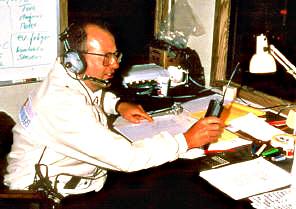 Pelle Rudh in the pit areas communication centre.
Pelle Rudh in the pit areas communication centre.
The fuel for the test was supplied by Shell and was transported to Talladega in large tanker-trucks along with a separate pump capable of filling the test vehicles at a flow rate of 120 l/min.The vehicles standard fuel tank ( modifications to the filler-pipe was not permitted ) took only 35 seconds to fill!
The service-pit was also equipped with compressed air lines to drive the power tools and to quickly change tires etc.
To ensure that sufficient compressed air was available, a large heavy- duty compressor was installed.
With the adverse weather experiences we gained from the pre test a diesel driven generator which could be quickly started upon the event of a electrical power failure was also required.
In the pit area a mobile trailer was used as an office and a communication center. Radio communication to and from the cars was also installed permitting important information to be quickly transmitted to drivers. It was also here that number of laps and lap times were officially recorded.
In the drivers rest area there was also a trailer including catering facilities etc.
Spare Parts
Each vehicle was allowed to carry spare- parts weighing a total of 5 % of the total vehicle weight plus 20 kg. In our case 87 kg was allowed.The spares were packed in an aluminum box anchored to the floor panel under the rear seat of each vehicle.
Prior to the start of the test a list of selected spare parts and their respective weight was sent to NASCAR who later inspected the parts upon their arrival at Talladega.
NASCAR representative checking that spare parts were in accordance with each vehicle's list of spares.
It is important to note here that each vehicle started the test as an individual vehicle this meant that spare parts assigned to one particular car could not be used for any other car.
The choice of spare parts was therefore given careful consideration. The main criteria for selection was that only components that couldn’t be repaired should be included.
Examples of such components were:
-Electronic ECM
-Alternator
-Electronic relays
-Wheel-bearings
-Turbo-charger
and -Cylinder head.
An exception was made for larger components i.e. exhaust system, windscreen etc which remained at the pit area.
Timekeeping, pit control
As mentioned earlier the FIA appointed NASCAR as the controlling body and vehicles were required to follow the regulations set by FIA.
Each vehicle was originally required to have transponders registering completed laps and lap times. This equipment would however cease to function should a loss of electricity in the Pit area due to thunder storms etc be encountered. This led to the decision to measure lap and lap times manually, 3 lap counters, 1 for each car and one in reserve at the control tower were needed during 24 hours.
In total NASCAR had 25 controllers involved in the control and follow up of vehicles in the pit area.
The NASCAR controllers were indeed kept very busy throughout the test. The data from three vehicle driving in excess of 1000 laps per day demanded extremely high concentration and close involvement of them so that lap times were correctly registered.
At the start of the tests we had a feeling that NASCARs representatives had their doubts about us being able to complete the test. We could hear them saying "this won´t take long" and "It with be all over within a week" and "There isn’t a vehicle in the world that can be driven flat out for 100,000 km on this speedway"
The start of The Long Run
After all the preparations it was time to start the challenge, at 08.00 on the 7 October 1986, Les Richter waved the starting flag to the first test vehicle and I was behind the wheel.
START 08.00 on October 7, 1986
It was very important to get a good start. The first record distance was a relatively short 10 km covering barely 2 laps of the 4,28 km long race-track. Our target was that from a standing start reach an average speed of min.200 km/h. This was achieved with a measured vehicle speed of 202,798 km/h.
Before the vehicle returned to the pit for the first time the highly acclaimed International record for standard vehicles during one hour of driving was also broken at an average speed of 220,449 km/h.
Our chase for more records continued and during the first 24 hours of driving 13 International distance and time records had been broken.These records were noted as both Swedish and American.
Swedish, in the fact that the records had been broken using a Swedish manufactured vehicle and American in the fact that the test took place in the USA.
The two remaining vehicles later started the Long Run placed 20 minutes apart from each other.
The cars were performing like clock-work.
The driving schedule that was determined from experiences from the earlier pre-test functioned perfectly in respect to fuel tank filling and tire changes. Fuel consumption was measured as being 27 liters/100 km and it took an hour of driving to empty the 60 liter fuel tank.
Subsequent filling of the fuel tank in the pit took only 30-35seconds to perform thanks to Shell´s well trained staff.
Concerning tire-wear : During the pretest it was already noticed that wear was occurring most of all on the inside of the left front tyre.
We estimated that the total tires that were going to be needed during the whole test could be significantly reduced by switching the front tires with each other.
After 6 hours of driving the front tires were switched and then replaced with new ones after 12 hours of driving. After 24 hours of driving the rear tyres were then replaced.
At Talladega the gear-box is subjected to very special loadings which place high demands on internal components and lubrication.
The only gear changes that took place during the test was when drivers left the pits after refueling. Here the drivers accelerated quickly through the gears until 5th gear is engaged. After this there were no more gear-changes needed until the next pit stop.
The Saab 9000 gearbox was designed not to require any oil changes throughout its normal service life
Diary
Below is an account of the most important events that took place during the Long Run.
It is important to note that the vehicles standard service schedule was precisely followed.
Standard practices were employed throughout the complete test.
7 October
After 1134 km of driving vehicle No3 was noticed to have a coolant leak from the water pump. The pump was replaced in a time of 15 minutes and the test continued.
After 2150 km mechanics changing the tires on vehicle No1 noticed that grease was leaking from a drive shaft constant velocity joint. New grease was packed into the joint and the clip securing the protective rubber boot was tightened. Vehicles 2 and 3 were also later checked.
8 October
The driver in vehicle No.3 reported that exhaust gas temperature was exceeding the 950 °C maximum temperature set for the test.
This created some concern as it coincided with the fuel tank reaching empty. A possible cause for the high temperature was thought to be that the fuel feeder pump in the fuel tank was running dry.
The consequence of this being that at the end of each driving pass the engines fuel mixture became too lean ,leading to an increase in exhaust gas temperature and possible damage to the exhaust valves.
A quick decision was therefore taken to reduce the amount of laps driven between tank filling, 45 laps instead of 50.Each vehicle was later also checked to see if the feeder pump in the fuel tank was positioned correctly.
9 October
The turbo boost -pressure was checked and minor adjustments were made on all vehicles.
10 October
The fuel pump was changed on vehicle No.2. High noise levels from the pump indicated that damage had taken place on account of lack of fuel.
It started to rain very heavily saturating the whole of the race-track. Local radio stations reported that thunder -storms were to affect the whole of Alabama 30mm of rain could should be expected to fall during the coming 24 hours! Suddenly all the lights went out in the pit on account of a power–cut. Thanks to our diesel driven generator it took only three minutes for lighting to be restored. Concerns focused on the drivers and if it was possible for them to continue to drive the vehicles in such heavy rain and extremely poor visibility? The NASCAR controllers simply shook their heads stating that, ‘here in the USA all stock- car races are immediately stopped as soon as it starts to rain! NASCAR officials had earlier indicated that they were willing to stop the clock and further driving if weather conditions became too bad. The Saab team decided that despite the adverse weather conditions they would nevertheless continue to drive the vehicles. We had after all decided that the test should be run non –stop and with no delays on account of bad weather!
The wet weather however affected the vehicles rolling resistance. Top speeds were reduced by 15 kmh,increasing lap times by 2 seconds.
The Pirelli P600 tires performed extremely well in the wet driving conditions.
The regular 20 000 km service was later performed on all vehicles.
11-14 October
Nothing out of the ordinary noted ,monotony though creeping in.
15 October
Regular 40 000 km service performed on all vehicles
16 October
Oil leakage noted from the power-steering hose on vehicle No 1 –the hose was replaced and driving continued.
17 October
The air-cleaners were replaced on all three vehicles.
Vehicle No 3. Concerns for the high exhaust gas temperature being 30 °C above the maximum allowable 950 °C. Fault most probably on account of a malfunctioning pressure regulator and incorrect fuel system pressure.
18 October
Despite all precautionary measures vehicles 1 and 3 continue to be losing power.
At 52 776 km respective 58 207 km both vehicles were stopped from further driving to perform a cylinder compression test. The result revealed that one cylinder had extremely low compression indicating that the most probable cause of this was due to a damaged exhaust valve.
The project manager decide to have the cylinder head removed from the engine to make a check on the condition of the exhaust valves. On close examination the exhaust valves in cylinder 1 and cylinder 2 were seen to be damaged.
Instead of replacing and lapping in new exhaust valves a completely new cylinder head-included in the vehicles list of spare parts - was fitted. For safety reasons the turbo charger on vehicle No.3 was also changed it was thought that small segments of the exhaust valves may have broken off and had caused damage to the turbo charger turbine.
Exhaust gas temperatures exceeding 950 °C during long periods of time can lead to damage of the exhaust valves sealing surfaces causing them to leak.
It is important to point out that under normal driving conditions the exhaust valves perform satisfactorily as such high temperatures are seldomly reached.
19 October
Regular 60000km service on vehicles 1 and 3 performed. Oil leakage again on vehicle No1 from the power steering pump. New hose fitted. Initial problem due to a small crack on the pump bracket. Damage caused most probably to excessive vibration.
20 October
Rain again! Difficult driving conditions due to to heavy rain and poor visibility. Certain drivers try to follow the white line on the inner track,others stay close to the outer safety wall.
Due to the excessive rain a lot of water had accumulated at entrance lane to the pit. This caused certain problems for the skilled rally driver Kjell Olofsson as he returned his vehicle to the pit.
Despite all of Kjells rallying experience he approached the water a little too fast causing his car to aquaplane and skid off on to the surrounding grass area!
There was no visible damage to the vehicle so a new driver took over.
It wasn’t long however before the new driver indicated that something was wrong, heavy vibrations were felt from the front wheels as the vehicle gained speed.
The vehicle was called back to the pit and the front left wheel was removed. This revealed that a large amount of grass and mud had become packed between the wheel rim and the tire. A new wheel and tire was fitted solving the problem.
Erik Carlsson ( on the roof ) had his own theories to the incident and speculated that Kjell had driven far too slowly that day and that a bird had had sufficient time to build a nest in the wheel rim!
21 October
Vehicle No.3 was losing power again. A detailed inspection indicated that No 1 piston was damaged The engine was approved to be removed and a new piston was fitted along with the earlier changed turbo-charger unit.
The mechanics performed this task in 2h and 49 minutes - even that must be a record in itself ! Bear in mind also that the engine was red hot after coming directly from the test track when the work started!
Good that we had such skillful mechanics with us!
22 October
Brake pads were changed on vehicle No.1. During the test the brakes are seldom used other than braking from 220 km/h to 0 kmh at every pit stop.
A condition that’s considered to be hard on the brakes but quite normal for the braking system to withstand.
23 October
Vehicle No.2 noted with low power due to exhaust valve damage on cylinder 3. A new cylinder head was fitted.
Regular 80 000 km service performed on all vehicles.
Vehicle No.3 - Fuel Pump noise. Fuel feeder pump replaced.
Vehicle No.1. Low power noted. Removal of the cylinder-head and exhaust valve replaced on cylinder number 2.
All three vehicles approaching 80 000 km (50 000 miles ).The first world record being well in our sights.
At 01.00h I drove vehicle No 2 into the pit for its 80000 km service. A new world record at 50000 miles (80465 km) had been made at an average speed of 213,686 km/h.
Champagne corks were popping but unfortunately only a small drop allowed for me - I was required to keep driving!
NASCARs controllers and officials had now ceased to be surprised by our achievements and happily joined in the celebrations with us.
24 October
Low engine power reported on vehicle No.3 due to exhaust gas leakage Cyl 1.New exhaust valve fitted.
25 October
The ignition timing on vehicle No.2 was adjusted due to high exhaust temperature.
Tiredness was noticeably creaping in on team members which was hardly surprising following the irregular 8 hour driving passes together with the relatively short breaks for a rest.
Despite this the moral within the team is good and further inspiration being gained by the fact that the first world record had already been broken (50 000 miles) and the count- down to achieving the magical 100 000 km world record had started.
27 October
At 08.12 local time the first vehicle (No.2) completed 100000 km of driving and our dream of setting the magical world record had been fulfilled with a registered average speed of 213,299 km/h(132,542 mp/h )
I was given the honor of driving the vehicle over the final lap.What a fantastic feeling of satisfaction and achievement it gave me. After two years of hard work preparing for the test our goal had been reached.
During the night the remaining other two vehicles passed the magical 100 000km.Car No.1 with an official average speed of 210,081 km/h and car No3 with an official average speed of 208,804 km/h.
Despite this, the LONG RUN continued.
It wasn’t long before the news of the world record reached the motoring press and the following afternoon we were visited by several leading motoring journalists who had specially chartered an aircraft to join us at Talladega.
The finishing line... 08.12 on October 27, 1986... A new world record...
At four o´clock after 105 000 km of driving NASCARs'chief controller Les Richter waved the finishing-flag in front of all three vehicles travelling side by side over the finishing line.
The LONG RUN was over.
Two World-records, all categories
RESULTS
21 International records
2 World records all categories
World records
The large notice-board outside the Talladega racetrack acknowleding Saab's achievements.
The staff at Talladega were equally proud of Saabs achievements and to show their appreciation Saabs world record was displayed on the large notice board outside the entrance to the speedway.
Our achievements quickly became acknowledged even within the American motor industry. Chrysler had shown particular interest from an early stage of the test frequently contacting the Talladega staff for news of how the tests were progressing?
Their interest was presumably on account that Chrysler had included a turbo -charger in the design of the Chrysler Le Baron´s 2, 2 liter engine.
Chrysler were reported to have been having certain quality problems so they were extremely interested to learn just what Saab had done to make their engines function so well?
Barbecue celebration party
On the 28 of October a large celebration barbecue was organized for all people taking part in the Long Run at Talladega.
The party was a huge success and our American friends and colleagues celebrated our achievements with us.Erik Carlsson with all his rallying achievements stated that The Long Run was one of the best motoring experiences he had been involved in throughout his career.
SAE paper
The Society of Automotive Engineers (SAE) is an American organization overlooking developments within the American motor industry. Members of the organization have direct access to published automotive articles and reports etc and can attend several of the SAE conferences frequently organized throughout the world.
The positive reaction within the motor industry that the Long Run had created prompted Saab, together with Garrett the turbo manufacturer to write a detailed technical SAE paper of the event performed in Talladega.
The SAE paper No 870733 was compiled jointly by Brage Sundström , Kenth Johansson, myself Olle Granlund , Steven Rossi , and Torsten Åman.
Certain SAE reports are selected to be presented verbally at a SAE conference. The Long Run was considered to be of such interest that a presentation of the paper was later made on 22 January 1997 in Monte-Carlo.
I personally made this presentation which concluded with several engineering related questions being raised.
At that particular moment in time turbo -chargers had started to become interesting for automobile manufacturers throughout the world.
According to Garratt Saabs testing at Talladega had positively influenced car manufacturers considering using turbo chargers in their engine design.
Honoring our achievements
On the 6 the of December 1986 Saabs achievement in The Long Run at Talladega was honored by the Swedish sports car association at their 50th anniversary banquet held in Stockholm.
Sten Wennlo receiving a victory laurel-wreath
and Olle Granlund the sports-car association's gold medal from HRH Prince Bertil
The gala celebration was held in The Blue Hall in Stockholm's Town hall
We were were also honored at the FIA´s annual banquet held in Paris on the 19 of December 1986.
Stig-Göran Larsson and I attended the banquet and we were presented certificates of merit for our world records by Burdette Martin. He pointed out that the results showed that car-racing and the development of standard production vehicles have a lot in common, thereby stimulating the car industries throughout the world.
FIA presentation in Paris
All drivers were awarded a diploma
Gold Medal
Drivers' Diploma
Record Table
FIA´s June bulletin 1987 included a final official results table for the Long Run …19 International records and 2 world records.
These results were also recognized as national records in Sweden and USA.
As soon as a record had been broken this was noted on the result board by a very talented painter registering all the data –it was facinating to see this skillful man at work.
| 10 km | 202,798 km/h | 126,064 mph |
| 10 miles | 207,191 km/h | 128,770 mph |
| 100 km | 218,681 km/h | 135,911 mph |
| 100 miles | 219,612 km/h | 136,490 mpg |
| 1 timme | 220,449 km/h | 137,010 mph |
| 500 km | 217,284 km/h | 135,043 mph |
| 500 miles | 217,050 km/h | 134,898 mph |
| 1 000 km | 217,651 km/h | 135,271 mph |
| 6 timmar | 216,968 km/h | 134,846 mph |
| 1 000 miles | 216,519 km/h | 134,651 mph |
| 12 timmar | 215,057 km/h | 133,550 mph |
| 5 000 km | 214,936 km/h | 133,475 mph |
| 24 timmar | 214,920 km/h | 133,465 mph |
| 5 000 miles | 214,486 km/h | 133,279 mph |
| 10 000 km | 213,473 km/h | 132,650 mph |
| 10 000 miles | 212,564 km/h | 132,085 mph |
| 25 000 km | 212,687 km/h | 132,161 mph |
| 25 000 miles | 213,816 km/h | 132,863 mph |
| 50 000 km | 214,297 km/h | 133,162 mph |
| 50 000 miles | 213,686 km/h | 132,782 mph |
| World record! | World record! | |
| 100 000 km | 213,299 km/h | 132,542 mph |
| World record! | ||
| World record! |
The hand-written notice board of Talladega including all results
Donation of one of the Saab 9000 test vehicles.
In connection with the Talladega race-track there is a reception hall and museum –officially named as the International Motor Sports Hall of Fame and Museum.
The museum has over 200,000 visitors per year and is widely known for its collection of racing cars.
The entrance building to the Talladega museum
When the Long Run was completed Saab donated the pre test car to the museum.
Saab USA organized this along with compiling relevant information for the museum´s visitors to read
Ref Photos a include Don Neman photo
Donated pre-test car to the museum
Bob Sinclair handing over the car keys to Don Neman
The official donation of the vehicle was done on the 3rd may 1987 in connection with the large stock –car competition -Winston 500 race. In front of 150000 spectators I drove the vehicle around the Talladega race track. Bob Sinclair, Steven Rossi and myself later handed over the ignition keys to the museums chief Don Neman. A speaker at the track informed spectators of what exactly Saab had achieved with the car which was good advertising for the company in front of so many spectators.
The Talladega version of the Saab 9000
In order to recognize the world records achieved by the Saab 9000 a special Talladega version was developed and launched at the Stockholm car show in February 1988 specifically for the Swedish market. In order for Saab to use the name Talladega , a registered trade-mark , it was necessary to gain the approval of the Royal Patent and Registration Office in Sweden.
Approval was granted on the 11 th December 1997.
Talladega version av Saab 9000.
Talladega name approved for Saab usage.
The diploma awarded to Saab by Governor Georg Wallace
Talladega diploma
During our stay at Talladega we came in contact with many car enthusiasts at the hotel and at local filling stations etc. What Saab was doing at Talladega was generally well known and their admirations for our achievements was very noticeable. Nobody had previously driven such long distances at such high speeds.
The news of Saabs world records quickly reached the staff at the town hall in Talladega who informed that the results of Saab in the Long Run had helped getting Talladega more recognized even outside the borders of Alabama.
As a token of their appreciation I was awarded a diploma signed by George C Wallace the Governor of Alabama.
It may be of interest to learn that that George C Wallace was the democratic candidate for the presidency of the USA in 1976 performing his work in a wheel -chair.
Some interesting data
- The vehicles covered approximately 24000 laps during 21 days of driving.
- Every car consumed 27000 liters of fuel.
- Every car used 120 tires
- Regular services performed at 20 000 km ( new engine oil ,filter, spark-plugs) took at the start of the test 4 minutes to complete ,at the end of the test 2 minutes 18 seconds.
- Each day the cars were driven a distance equal to driving from Stockholm to Rome and back.
- 100,000 km equals approximately 2, 5 timesaround the world at the equator.
- The turbo-charger rotated 30 billion revolutions.
- The engine rotated 165 million revolutions.
- Each piston had moved a distance of 29000 km.
Press and Information
Torsten Åman was in charge of all external information and he frequently sent out bulletins of how the tests were progressing including also a list of records which had been broken. Our ambition from the start of the tests was that we should be very informative about the testing – indicating that we were confident of the vehicles quality and durability characteristics.
Internal information was returned to Saab in Trollhättan on a daily basis.Results were quickly noted on a large notice board placed outside the production line entrance in Trollhättan. Data showing covered distances, vehicle speeds and the number of records that had been broken were clearly noted for all to see.
The interest at Saab of how things were progressing at Talladega was huge, production staff were known to come in a little earlier prior to their afternoon shift beginning just to gain fresh news and the daily report of progress from Talladega.
It was generally felt that the Talladega record attempt increased relationships within the company,everyone felt involved – it was after all a vehicle developed and manufactured by Saab in Trollhättan.
The Press and driving of the test vehicles
When the Long Run was completed and vehicles had covered 100 000km a number of motoring journalists were invited to visit Talladega and test drive the vehicles for themselves.
To personally have an understanding of just what it was like to drive vehicles at Talladega was appreciated by all and positively reported. A representative from the PR agency responsible for marketing Saab in the USA calculated that the publicity gained from the Long run was worth at least $5 million in equivalent advertising costs.
Jubilee
On the 28 October 2006 the 20 th jubilee of the Long Run was celebrated at the Saab museum in Trollhättan. Approximately 30 Talladega drivers attended, exchanging individual memories and driving experiences from Talladega.
All were in high spirits and together with a fine dinner a pleasant evening was had by all.
Resume
Firstly I should like to thank Saab's management for having belief in the whole idea behind the Long Run and for actually allowing us to perform the test.
It is on account of the full support and engagement from all involved in the test that the project was a success from the start to finish.
Furthermore I wish to thank all my colleagues within the Saab organization.Their numerous skills and professional involvement in the development and manufacture of the Saab 9000 shall never be forgotten.
Some of the drivers and mechanics after reaching the finishing line.
Besides all the record braking achievements valuable engineering data was obtained from completing the test at Talladega. The water cooled turbo-charger´s performance and durability throughout the test impressed probably most of all.
After the completion of the test each engine was disassembled and all components fully examined for wear.
The examination proved that very little wear had taken place and that engine components were still in an in extremely good condition. This was noted in the SAE paper written upon the completion of the test.
Our calculations and predictions of the thermal loadings expected to affect engine components etc proved also to be correct.
We had calculated that the engines exhaust valves would become damaged after the vehicles had covered 60-70 000 km and of being exerted to a continual exhaust temperature of approximately 950 °C. In practice though during normal driving this never occurs.
Thanks to the successful driving at Talladega, Saab established that turbo charged engines are very reliable which can be recognized by the increasing use of Turbo chargers on engines being produced today.
From successfully completing the Long Run at Talladega, Saab has left its mark in automobile history books, forever.
_______________________________________________________________________________________________________________________________________________ Thanks to the following people who assisted in the production of this report:
- Britt Back who has written this document on her computer
- Olle Johansson who has edited the photography
- Torsten Åman for his contribution of facts and figures
- Ray Beaufoy who has been involved in the translatio from Swedish to English
